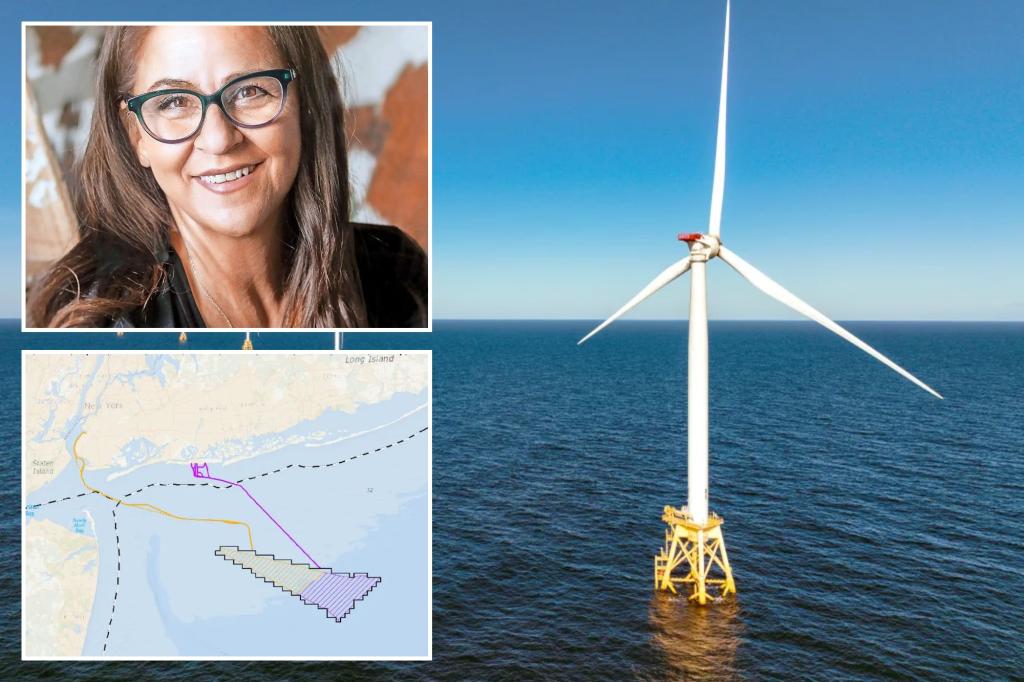New Yorkers would be forced to pay 2.5 times the market rate for electricity generated by the Empire Wind One offshore wind farm if the deal goes through, according to an independent financial analysis.
The Trump Administration paused construction of the controversial project — 54 turbines in the Atlantic Ocean some 14 miles south of Long Island — last week, saying it needs further review. The project has seen strong backing from Gov. Kathy Hochul and Mayor Eric Adams.
Trump’s move was welcomed by those who claim the project is going to overcharge taxpayers.
“New Yorkers are entitled to clean, affordable, reliable energy,” Christina Kramer, president of Protect Our Coast Long Island New York, told The Post. “And this is none of those things.”
The organization had requested analysis from Edward P. O’Donnell, a New Jersey nuclear engineer and consultant who spent 35 years running nuclear plants.
“Empire Wind One was awarded a contract to charge $155 a megawatt hour (MWH) for their power,” O’Donnell told The Post. “It’s a subsidy, because if you didn’t have Empire Wind One, the utilities would buy [power] from the wholesale market at about $50 a megawatt hour.”
The total amount of the subsidy, O’Donnell said, would be $9 billion. The New York Independent System Operator (NYISO), who manages the state’s power grid, is mandated to buy power generated by offshore wind over cheaper power from gas-fired or nuclear plants.
The federal Inflation Reduction Act, signed by former President Joe Biden in 2022, also provides a 30% tax credit for offshore wind projects that begin construction before Jan. 1, 2026, and additional credits are available for using US labor and building materials.
“A company who is building an $8 billion offshore wind project — that’s what they’re costing — can get up to half of that refunded to them as a tax credit,” O’Donnell said. “That’s on us, federal taxpayers throughout the country. We’re all footing that bill.”
Congress may repeal the federal tax credit, O’Donnell said, but he also expects that would get thrown back at the consumer.
“If and when the tax credit gets repealed they would then lose $2 billion of their capital funding. They would go back to NYSERDA and say, we need another $50 per megawatt hour, or we need $205 or $210 per megawatt hour, whatever, or else we can’t go forward,” he speculated.
O’Donnell points to previous examples of Empire Wind One and another contractor, Sunrise Wind — which is building 84 turbines in the ocean 30 miles east of Montauk Point — having already done this.
In 2019, NYSERDA awarded a contract to Empire Wind One, owned by the Norwegian company Equinor, at a rate of $118 per MWH for 25 years. It also agreed to pay Sunrise Wind, owned by Orsted, a Danish energy giant, $110.37 per MWH for 25 years.
Three years later, both companies wanted rate hikes, citing high costs and supply chain bottlenecks caused by the COVID-19 pandemic.
The requests were declined by the New York State Public Service Commission, but NYSERDA gave them the opportunity to rebid their contract and awarded them more money.
NYSERDA re-signed the developers with contracts at significantly higher prices: $155 per MWH for Empire Wind One, a 31% increase, and $146 per MWH for Sunrise, a 32% price hike.
“The Empire Wind One rebid ratepayer subsidy will total $9 billion over the life of the facility,” O’Donnell wrote in his report. “The 2024 present value of these above-market ratepayer costs is $6.2 billion, compared with $4.4 billion for the original Empire Wind One contract.”
O’Donnell claims New York ratepayers will provide $18 billion in subsidies to the two foreign offshore wind companies.
With the ratepayer and federal subsidies, O’Donnell says his research shows Equinor would see a rate of return on their investment over 20%, much higher than the 9% regulated utility companies are generally allowed to earn.
“I think that no public utility should be making money off of the residents. A public utility is supposed to be just that — a service that’s provided, that is created out of our tax dollars in part. But having these private equity companies make a fortune off of us after we’ve subsidized it is a proverbial slap in the face. We’re onto it, and we’re not going to stop,” Kramer added.
Empire Wind declined to comment on the subsidies. A NYSERDA spokesperson declined to comment on the economic analysis but complained about its sponsor.
“Protect Our Coast Long Island is a vocal critic of offshore wind energy and has been engaged in a strategic political effort to derail New York’s offshore wind industry and the substantial economic opportunities it delivers,” the spokesperson said via email.
“Staff of the Department of the Interior has obtained information that raises serious issues with respect to the project approvals for the Empire Wind Project,” Secretary of the Interior Doug Burgum wrote in a Wednesday letter to the Bureau of Ocean Energy Management.
“Approval for the project was rushed through by the prior administration without sufficient analysis or consultation,” he added.
Kramer is pleased construction has stopped, but added: “I think that we’d be even more elated if they said, ‘Well, we’re just going to put a full stop to them.’ ”
Read the full article here


